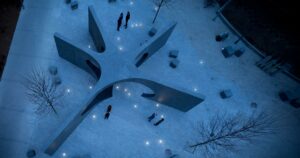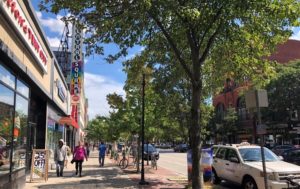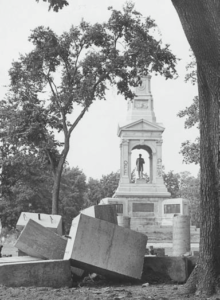Commentary on Radical Protests in the 1960s
by Stephen Kaiser, reprinted from Cambridge Day
If the really radical protesting began in 1967, here we are having an historical reunion of sorts fifty years later. In Cambridge, I was the editor of the Catalyst, the newspaper of the Graduate Student Council at MIT. I covered two of the Harvard Square riots, as I recall in 1969 and in May 1970.
In 1969, the radicals came together at Harvard Square, but I cannot remember the trigger to the protest. There was a long line of MBTA buses that had delivered busloads of state Police to enforce Law and Order. They were parked from the Harvard Book Store to the T Kiosk, and the physical dynamics were like a storm at sea. First there would be a wave of protesters moving down Mass Avenue towards the Square, and then there was a second wave as state police pushed the radicals back by an aggressive charge, with their truncheons out. Both sides were very mean and violence seemed to be everywhere.
Here I was an interloper from MIT and a journalist too. What was I supposed to do? I certainly did not want to be trampled or beaten up by anyone. I found myself in the no-man’s land between the radical and the police surges. A creeping worry began to overtake me, about my own safety.
Then I noticed an MBTA bus driver, in regular uniform, standing next to his bus, in the street. He was relaxed and had his arms folded, simply standing there. So I walked over next to the bus driver, stood with my back to the bus, with my arms folded too and thought that if no one was attacking the bus driver maybe that was the safest place to be.
So I watched the surges go one way and then back and forth. I wonder if the photo of the angry protesters, middle fingers upraised, occurred at that 1969 riot, and whether the radicals were taunting the state police.
During one of the moments of withdrawal by the state police, I decided to head down Mass Avenue towards Central Square, and the protesters who had momentarily been scattered. I ended up inside a church sanctuary near Arrow Street, and had a chance to rest from all the tumult outside. I recall standing near the door, where a man outside had walked up to argue with the radicals inside. He was very conservative in his politics and was opposed to the violence and the disrespect for law. As he was speaking, we noticed another state police surge coming down from Harvard Square. We may have been in a sanctuary, but a closed door makes an even better one.
So leaders inside quickly closed the door, leaving the patriotic conservative outside, standing on the church steps, all alone. I never got to see what happened next: did the man meet up with the wildly-swinging officers and their truncheons? Their “sticks” were like small baseball bats, but could do a lot of damage. The frustrated officers were in a mood to beat up anyone who could be seen as a protester.
Those were some of my fragmentary memories of the first riot in Harvard Square, almost 50 years ago.
I remember the second riot much more vividly. It was early May 1970, and four students had just been shot by National Guardsmen at Kent State University in Ohio. A wave of fear and indignation swept across many college campuses : a mass protest was immediately planned. The word went out that there would be a mass rally against the Vietnam War and against the “Establishment” of politicians, businessmen, and government bureaucrats who were seen as responsible for the war and the draft, and for not getting us out of the war.
The mass rally was to be held at Harvard Stadium … Harvard University had quickly made it available for all the protesters — the tensions of the time allowed little choice. Flyers went out with plans for marches from various Boston campuses. My recollection is that Memorial Drive was shut down to provide a marching path for people to join from MIT and the Back Bay — I believe Storrow Drive stayed open to traffic.
I did not attend the Harvard Stadium rally, but I remember figuring that the aftermath could be another riot at Harvard Square. The march and rally organizers were closer to being Moderate Students Against the War, rather than militant radicals. So the marchers were very well behaved getting to Harvard Stadium and attending the rally. I got to Harvard Square about the same time as waves of rally attendees were coming back from the stadium. A different form of confrontation now began.
A few months before I had gone to work for the old MDC, which has responsibility for parks and Memorial Drive and had its own Police Force. I was told at some point that MDC Police were at Harvard Square, including some who recognized toughs from Dorchester who were out for a fight. But the authorities did not send in the State Police or any waves of police. The march organizers went around trying to keep the peace, dissuade any violence or vandalism, and urge everybody to keep their cool.
Many rowdies were trying to stir people up and create another riot. At one point a contingent of them went off chanting through Harvard Yard and broke a few windows. Some stores in Harvard Square also suffered from broken windows. But in the end, given the great societal tensions at the time, the images of the recent killings at Kent State, and the collapsing confidence of many college officials and other Establishment figures, the riot in May 1970 was relatively mild and controlled, and eventually everyone dispersed. Police in uniform were virtually absent as far as I can remember.
May of 1970 was the peak of street protest in America, and represented a major watershed of mass protest and a gradual ebbing of the radical flow influencing the public debates and discussions. In 2003, efforts were made to have nation-wide protests against the invasion of Iraq in 2003, but I noticed that the activists were generally older, with many gray hairs. There were few young protesters against the Establishment.
So it remains for the Historians to ask what was it about the 1960s (and the Vietnam War) that triggered such massive protests and even the “radicalization” of MIT fraternities? What were the forces that undermined, disarmed and scattered the protesters? The closest thing to a major street protest we have had recently was the Women’s March on Washington after the Trump Inauguration. It was a mild affair with little long-term impact.
Cambridge residents who may be major history buffs also need to think about another protest that was sweeping America during the 1960s. From San Franciso to New Orleans, from Baltimore to Boston, citizens organized to stop major highway construction in large cities.
Cambridge’s fight was against the Inner Belt Expressway, and the peak years of these protests were 1965 to 1970 — the same years as the anti-Vietnam peak protests. But the road protesters used a completely different strategy. They organized neighborhoods, not youth and students. They did have marches and demonstrations, but they worked with their local politicians to fight the road.
Their leaders in the 1960s were national politicians like Tip O’Neil, Governors like Frank Sargent and conservative leaders like Senator Frank McCann and Mayor Dan Hayes. Organizers mobilized a wide swath of society against the Inner Belt, including Richard Cardinal Cushing of the Boston Archdiocese, business leaders at Alewife, Quaker activists, liberal think-tank academics and indeed hundreds of professors from Harvard and MIT who signed a newspaper ad in 1966 against the highway construction. The anti-highway protests were important because the aroma of violence was NOT in the air.
The goals were political. The organization of the late 1960s — The Greater Boston Committee on the Transportation Crisis — worked to coordinate activists and young professionals to work together, and to infiltrate state and city agencies to place internal anti-highway activists. I was one of them.
Once victory seemed possible, the organizers switched from street demonstrations and citizen organizing to lobbying and changing the policies of government. Gradually they won over the Governor, the Mayor of Boston, and many state legislators. They had support from government officials in Washington whose priorities were to support more housing and stop the highways.
The highway protesters across the country had a permanent effect at thwarting urban highway projects and undermining the power of the previously unstoppable “Highway Lobby.”
The Anti-War radicals of the 1960s shook the Establishment to its very roots, but in the end they were unable to undermine the power of the Military Industrial Complex — still so very much with us and active in military campaigns around the world. The historical lessons in all of this are fascinating, even after 50 years.
Stephen H. Kaiser
Minor Activist in opposing the Inner Belt Highway, 1968-1970.






